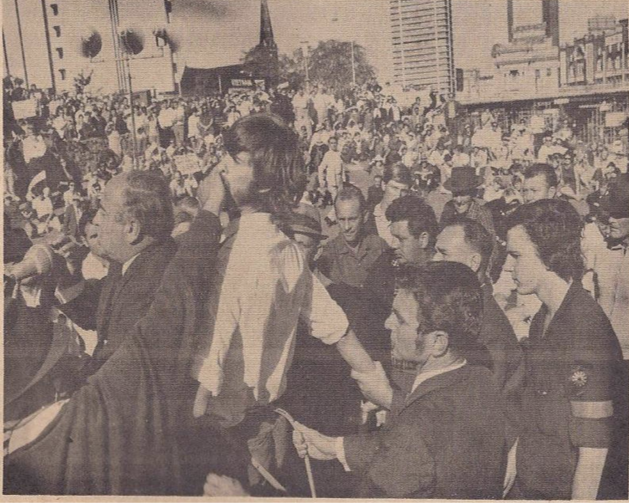Guest author Tim Briedis, host of the People’s History of Australia, writes on the Self Management Group (1971–77)
Out of the wave of global radicalism in the Sixties and Seventies came the libertarian socialist Self Management Group (SMG). Based in Brisbane/Meanjin, SMG’s size and level of organisation was unique. It had a ‘two-tier’ structure with at its peak two – three hundred activists in cells and sixty – seventy full members. It was arguably the preeminent far left group in the city throughout its existence from 1971-77.
Although beginning with a core of eight people, from 1971-73 SMG grew rapidly. Even that keen friend of revolutionaries ASIO noted its growth, writing that it had ‘developed a maturity and crystallisation of purpose’ and that ‘its policy of Self Management/Workers Control… has a distinct appeal to all sections of the Community in this present day and age’.
SMG had a cell structure, which meant that activists were organised at points of production where they studied or worked. Member Frank Jordan recalled that ‘the cell structure was fantastic… it prevents bureaucratic degeneration, the focus on workplaces reminds you of your own oppression… it discourages you from being a boss over other workers’. By 1973, cells existed at the two Brisbane universities, in hospitals, industrial workplaces, high schools, training colleges and in white collar jobs. The universities saw the biggest cells, with one strategy being barging into lectures or classrooms and trying to turn them into a political discussion about a key issue. This saw mixed success – some members recall their interventions leading to lengthy discussions, while in others the students forcefully rejected their presence.
SMG were prolific leafleters, producing an enormous array of material. They focused on ‘the politics… of day-to-day…existence not the usual connotations of politics’. One particularly sharp one, Boredom at the Office, declared that:
It’s nine o’clock. Once again I’m at my utterly boring monotonous job. My eyes wander to the grey haired man near me. This office has drained thirty years of his life. I can expect the same.
‘The response to it was electric’ recalled one member. The leaflets were used to build the organisation effectively.
High schools were sites of leafleting too. The leaflets were condemned in parliament and were illegal but they continued regardless. One member, Greg George, recalled that:
Several carloads of us would get to school during recess or lunchtime… the kids loved it. They’d rush out of the classrooms. We’d hand out the leaflets bamn bamn bamn and then we’d leave before we got caught.
In 1973, they distributed the broadsheet Self Management and the High Schools to nearly every school in Brisbane. One school with an SMG cell, an activist recalled, saw more progressive courses introduced while another had mass meetings around dress codes and authoritarianism. The Evans Deakins docks were described by ASIO as a ‘hot bed of industrial intrigue’ and SMG were involved in work stoppages, slow-downs and agitating for self-management. Through the University of Queensland cell a 1974 campaign against high workloads and assessment won some demands.
The SMG did have significant flaws. Members recalled experiencing serious sexism in the group, to the extent that Barbara Hart remembered that:
It was very difficult for women to get in (to the SMG). You had to get in through a man… We used to joke that every woman in it was the partner of a man (in the SMG). Eventually something happened and they let other people join.
They were unable to work in solidarity with Aboriginal people, despite the important struggles going on in this era. Some former members argued that they were very hostile and sectarian to other left groups. Ultra leftism was a concern, with some critiquing the overwhelming focus on revolutionary self-management as an end goal, rather than on supporting more tangible social movements. Eventually these tensions caused a three -way split in 1977, with some members joining the Trotskyist International Socialists, others the more feminist and anarchist oriented Self Management Organisation and the ‘old guard’ of the SMG forming the Libertarian Socialist Organisation.
Yet despite its faults, the SMG does show that it is possible for left-libertarians to create substantial organisations in this continent, beyond the small groups of a half dozen to a dozen people that have dominated the anarchist scene. Its focus on daily life and novel organisation into cells are intriguing strategies for radicals.
SMG never lost sight of its utopian goal of abolishing capitalism. They brooked no compromise with electoral politics. In December 1973, in a referendum on prices and incomes, they advised:
If habit drags your tired body to the local prison house for kids (school) to cast your compulsory, meaningless vote, that you write across the paper ‘Build a society based on workers’ councils, replace the parliament and bosses with a self-managed society’ you might feel a tingling sense of joy at the first such productive work you have done in a polling booth!
Remembering them is not just a commemorative activity, but a small part of reasserting the banner of revolution into the ideological domain of the present.
